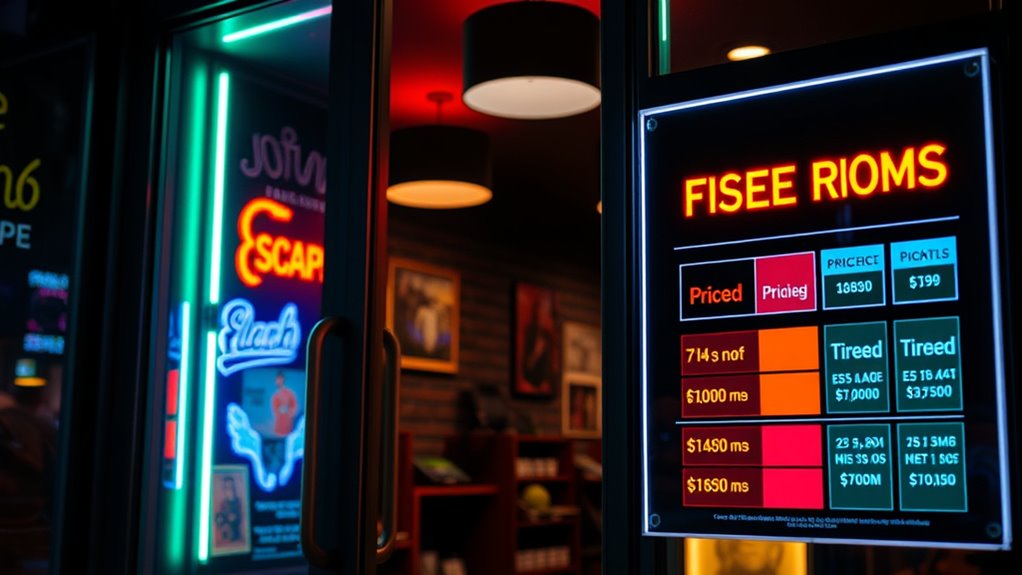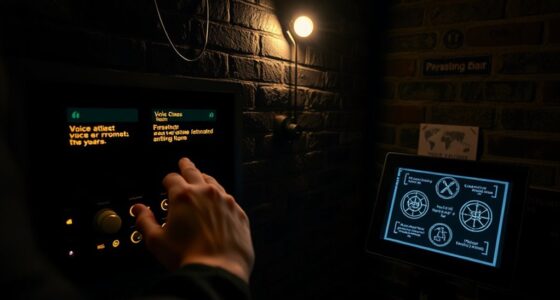Understanding the economics of escape room pricing means balancing customer perceived value with your costs and market competition. You should set prices that attract players without undervaluing your experience or sacrificing profitability. Adjust pricing based on demand, location, and features offered, ensuring each price point reflects your unique offerings. Mastering these principles helps you attract steady visitors and sustain growth. Keep exploring, and you’ll discover how to optimize your pricing strategy for long-term success.
Key Takeaways
- Pricing must balance customer perceived value with operational costs to ensure profitability and market competitiveness.
- Dynamic pricing strategies adjust rates based on demand, time, and special events to optimize revenue and occupancy.
- Understanding target demographics and willingness to pay guides setting appropriate price points and discount offers.
- Differentiation through unique features or premium experiences can justify higher prices and attract niche markets.
- Competitive analysis of market rates helps escape rooms position their pricing for sustainability and growth.

Understanding the economics behind escape room pricing is essential if you want to run a successful business or simply choose the best experience for your money. Pricing strategies play a pivotal role in attracting customers while guaranteeing your operation remains profitable. To develop effective pricing strategies, you need to grasp how consumer willingness influences what people are willing to pay for an escape room experience. When setting prices, consider that customers weigh the value they perceive against the cost. If your prices are too high, you risk turning potential visitors away; if too low, you might undervalue your offering and cut into profits.
Pricing strategies are essential to attract customers and ensure profitability in the escape room business.
Knowing your target market‘s consumer willingness helps shape your pricing decisions. For example, if your escape rooms are located in an area with a younger, budget-conscious demographic, you might lean toward more affordable pricing, offering discounts or group packages to attract larger parties. Conversely, if your location appeals to corporate clients or tourists seeking premium experiences, higher prices can be justified, especially if your rooms feature elaborate themes or advanced technology. Understanding what your customers value most allows you to tailor your pricing strategies accordingly, whether that means offering tiered experiences, add-on options, or bundled deals to maximize revenue.
Another key aspect is evaluating how much value customers associate with different features of your escape rooms. If your rooms boast intricate storylines, high-quality props, or expert-led clues, customers may be willing to pay a premium. Conversely, simpler setups might require more competitive pricing to entice bookings. Monitoring competitors’ prices can also provide insight into the market standard, helping you position your escape room competitively. However, don’t just copy their prices—consider how your unique offerings can justify a different price point.
Dynamic pricing can be an effective approach, especially during peak times or special events. By adjusting prices based on demand, you can optimize occupancy rates and revenue. For instance, raising prices during weekends or holidays can capitalize on higher consumer willingness to pay, while offering discounts during slow periods can fill gaps and generate steady cash flow. Incorporating holistic SEO strategies such as optimizing your website for relevant keywords can also attract more potential customers actively searching for escape room experiences.
Ultimately, understanding the delicate balance between your costs, consumer willingness, and perceived value will guide you toward the right pricing strategies. When you align your prices with what your customers value and are willing to pay, you not only boost your revenue but also foster customer satisfaction and repeat business. Mastering this aspect of the economics of escape room pricing ensures your venture remains sustainable and competitive in a growing market.
Frequently Asked Questions
How Do Seasonal Changes Affect Escape Room Pricing?
Seasonal demand considerably impacts your escape room pricing. During peak seasons like holidays, you might see higher prices because more people want to book, and demand is high. Conversely, in off-peak times, you could offer holiday discounts or special deals to attract customers. Understanding these seasonal trends helps you set competitive prices, maximize bookings, and boost revenue throughout the year.
What Role Do Competitor Prices Play in Setting Rates?
Did you know that 65% of customers compare prices before booking? Competitor prices markedly influence your rates, as you aim to stay competitive and attract more players. You should consider implementing dynamic pricing to adjust rates based on competitor moves, maximizing value perception. By staying aware of what others charge, you can better position your escape room to offer appealing prices that draw in loyal customers and boost revenue.
How Does Customer Demographics Influence Pricing Strategies?
You should consider customer demographics when setting your escape room prices, as demographic targeting helps identify what different groups are willing to pay. By using pricing segmentation, you can tailor your rates to specific customer segments, like families or corporate clients. This approach maximizes revenue and attracts diverse audiences, ensuring your pricing strategy aligns with their preferences and budgets, ultimately boosting your business’s success.
Are There Legal Restrictions on Escape Room Pricing?
You should know that there are some legal restrictions on escape room pricing, mainly to ensure pricing transparency and regulatory compliance. Regulations vary by location, so it’s crucial to check your local laws. These rules often prevent deceptive pricing practices and require clear disclosure of costs. By adhering to them, you protect your business and build trust with customers, ensuring your pricing strategies stay fair and compliant.
How Do Online Reviews Impact Pricing Adjustments?
You might find that online reviews secretly influence your pricing strategies. When reviews boost customer loyalty, you can justify higher prices through dynamic pricing, rewarding loyal players while attracting new ones. Conversely, poor reviews might force you to lower prices to recover reputation and sales. By monitoring reviews, you stay ahead of the game, adjusting your prices strategically to maximize profit and customer satisfaction in a constantly changing market.
Conclusion
So, next time you’re shelling out for an escape room, remember—it’s all just a clever game of numbers. They lure you in with mystery and challenge, then squeeze every last dollar as you scramble to “escape” the overpriced puzzle. Who knew that behind those locked doors, it’s really just a masterclass in capitalism disguised as fun? Happy spending—your wallet’s the real puzzle you’ll never escape from.








